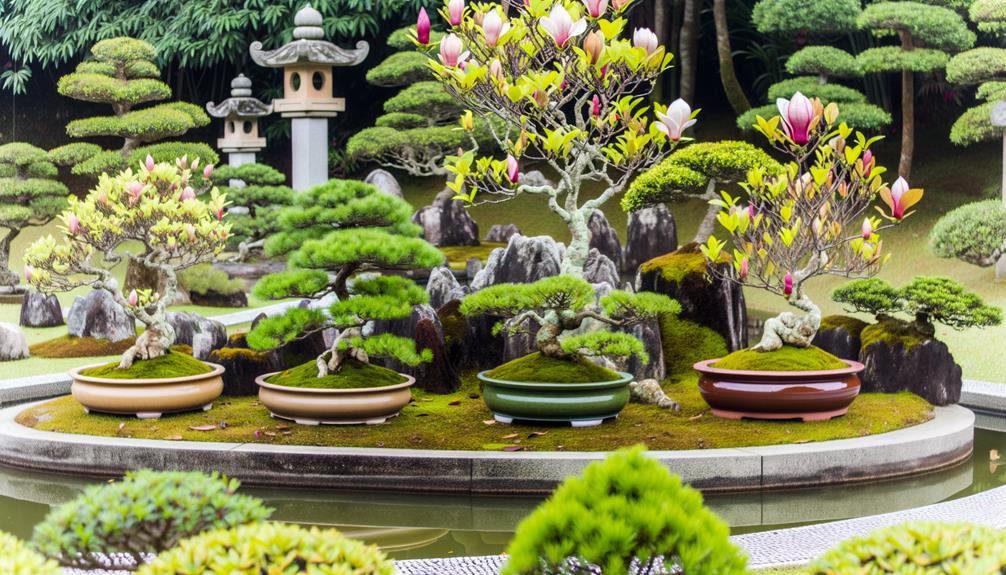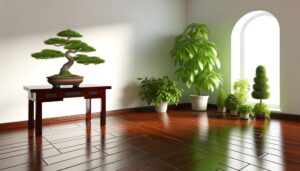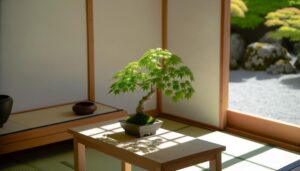How You Can Bonsai a Magnolia Tree Step by Step
Yes, you can bonsai a magnolia tree, particularly species like Magnolia stellata and Magnolia grandiflora. These species are suitable due to their compact size and manageable growth habits.
Essential techniques include selective pruning, proper wiring, and meticulous watering and fertilizing with balanced N-P-K ratios. Consistent soil moisture, pest control, and seasonal care are critical for maintaining health and encouraging flowering.
Proper selection of soil, pots, and care for seasonal changes further support the bonsai's development. By adhering to these guidelines, enthusiasts can achieve a visually appealing bonsai magnolia and further details await for best possible results.

Key Takeaways
- Magnolia varieties like Magnolia stellata and Magnolia grandiflora are suitable for bonsai.
- Both species are adaptable to bonsai techniques and manageable in size.
- Selective trimming and timely pruning help maintain the bonsai's shape.
- Consistent watering and proper fertilization are crucial for healthy growth.
- Regular monitoring for pests and diseases ensures long-term health.
Magnolia Varieties for Bonsai

While numerous magnolia species can be cultivated as bonsai, Magnolia stellata and Magnolia grandiflora are particularly favored for their manageable growth habits and ornamental qualities.
Magnolia stellata, commonly known as the Star Magnolia, is prized for its compact size and early spring blossoms, characterized by star-shaped, fragrant flowers. This species exhibits a shrub-like growth pattern, making it ideal for container cultivation.
Magnolia grandiflora, or Southern Magnolia, is renowned for its large, glossy leaves and fragrant, creamy-white flowers. Despite its naturally larger stature, skilled pruning and training can adapt it to a bonsai form.
Both species' adaptability to bonsai techniques, such as root pruning and branch wiring, contribute to their popularity among bonsai enthusiasts seeking visually striking and manageable specimens.
Selecting the Right Magnolia
When selecting the right Magnolia for bonsai cultivation, it is crucial to evaluate species suitability factors, including inherent growth patterns and leaf size.
Consideration of the local climate is also paramount, as certain Magnolia species exhibit better resilience to specific temperature ranges and humidity levels.
Additionally, understanding the growth habits of various Magnolia types will guide the selection process to guarantee development and maintenance of the bonsai form.
Species Suitability Factors
Selecting the appropriate Magnolia species for bonsai cultivation necessitates thorough consideration of growth habits, leaf size, and climatic adaptability to guarantee optimal development and aesthetic appeal. Species like Magnolia stellata and Magnolia grandiflora demonstrate desirable traits for bonsai, including compact growth forms and smaller leaves.
The leaf size is particularly essential because oversized leaves can disrupt the proportional harmony crucial in bonsai artistry. Moreover, evaluating the growth rate is important as slower-growing species allow for better training and shaping over time.
Flowering characteristics should also be taken into consideration; species with smaller, abundant blooms can enhance visual interest without overwhelming the miniature tree's structure. Selecting the appropriate species ensures both horticultural success and the refined beauty characteristic of bonsai.
Climate Considerations
Understanding the climatic requirements of different Magnolia species is crucial to successfully cultivating them as bonsai, as each species exhibits unique tolerances to temperature, humidity, and light conditions.
For instance, Magnolia grandiflora thrives in USDA hardiness zones 7-9 and prefers well-drained, slightly acidic soils, while Magnolia stellata can endure colder climates, suitable for zones 4-8.
Adequate sunlight is essential, yet species like Magnolia sieboldii can tolerate partial shade. Humidity levels should be monitored closely, especially for species native to more humid environments.
Additionally, microclimatic factors within your garden or bonsai space, such as wind exposure and frost susceptibility, must be considered. Properly matching the species to your local climate conditions guarantees a robust and healthy bonsai.
Growth Habit Preferences
Carefully evaluating the growth habits of various Magnolia species is essential for selecting the ideal candidate for bonsai cultivation.
Species such as Magnolia stellata and Magnolia grandiflora exhibit growth characteristics conducive to bonsai techniques. Magnolia stellata, known for its compact form and slow growth rate, is particularly suited for smaller bonsai specimens.
Conversely, Magnolia grandiflora, with its robust structure and larger leaves, requires more meticulous pruning and shaping. Understanding the internodal spacing, leaf size, and branching patterns of each species is vital.
Selecting a species with naturally smaller leaves and shorter internodes facilitates the miniaturization process. Additionally, the root system's adaptability to confinement plays an essential role in successful bonsai cultivation, necessitating careful species selection.
Preparing the Soil

Proper soil preparation is necessary for the successful cultivation of a bonsai magnolia tree. This process requires a well-draining substrate rich in organic matter and essential nutrients. The best soil mixture should include components such as akadama, pumice, and lava rock, which collectively enhance aeration and water retention.
Incorporating organic materials like composted bark or leaf mold provides vital micronutrients and promotes beneficial microbial activity. A slightly acidic pH, ideally around 5.5 to 6.5, is preferred to meet the specific needs of magnolia species. Ensuring homogeneous mixing of these components is important to prevent root rot and facilitate healthy root development.
Regular monitoring and adjustment of soil composition are recommended to sustain ideal growing conditions for the bonsai magnolia tree.
Pot Selection
Selecting an appropriate pot for a magnolia bonsai involves careful consideration of size and shape to balance root growth and aesthetic proportions.
Ensuring adequate drainage and soil aeration is essential to prevent root rot and support the tree's health.
Additionally, the pot's material and visual appeal should complement the magnolia's natural elegance while providing durability and stability.
Size and Shape Considerations
Selecting a suitable pot for a bonsai magnolia tree involves considering both the container's dimensions and its ability to support the tree's root structure and growth patterns.
The pot should be shallow, allowing the roots to spread horizontally while limiting vertical growth, which is vital for maintaining the tree's miniaturized form.
The width of the pot must be proportional to the canopy's spread to guarantee stability and aesthetic balance.
Additionally, the material of the pot, whether ceramic, plastic, or clay, must provide adequate thermal insulation and moisture retention properties.
These factors are essential in creating an environment that promotes healthy root development and sustains the tree's overall vigor and form.
Proper pot selection is necessary to achieve the desired bonsai aesthetics and health.
Drainage and Soil Needs
In addition to size and material considerations, a bonsai magnolia tree pot must be equipped with effective drainage systems to prevent waterlogging and root rot, which requires the use of well-draining soil compositions tailored to the tree's specific horticultural needs.
Incorporating a substrate mix made up of akadama, pumice, and lava rock can provide optimal aeration and moisture retention. The pot should include multiple drainage holes to facilitate excess water expulsion. Moreover, a layer of coarse gravel or mesh at the bottom enhances drainage efficiency.
Regular monitoring of soil moisture levels is essential, as magnolia roots are particularly sensitive to prolonged saturation. Implementing these measures ensures the tree's root system remains healthy, promoting overall vigor and growth.
Material and Aesthetics
The material and aesthetic qualities of a bonsai pot greatly influence both the visual appeal and the health of a magnolia bonsai tree. Selecting a pot made of high-quality, porous material such as ceramic or clay is essential for maintaining ideal root aeration and moisture balance. The pot's size should allow ample root growth while encouraging the dwarfing effect characteristic of bonsai.
Aesthetically, the pot should complement the magnolia's natural grace, often achieved through subtle, earthy tones that do not dominate the tree's foliage and flowers. Additionally, choosing a pot with sufficient drainage holes is necessary for preventing root rot and ensuring healthy growth. Therefore, pot selection combines functionality with visual harmony, enhancing the overall bonsai composition.
Pruning Techniques

Pruning techniques for a magnolia bonsai require a strategic approach to guarantee proper branch development and overall tree health. Key actions include selective trimming to maintain shape, promote air circulation, and encourage secondary branch growth. It is critical to prune during the dormant season to minimize stress and potential disease. Use sterilized, sharp tools to make precise cuts, ensuring rapid healing and minimal scarring.
| Action | Timing | Tools Required |
|---|---|---|
| Selective Trimming | Dormant Season (Winter) | Pruning Shears, Scissors |
| Leaf Pruning | Late Spring, Early Fall | Scissors |
| Root Pruning | Every 2-3 Years | Root Hook, Shears |
| Deadwood Removal | Anytime | Concave Cutters |
| Pinching New Growth | Growing Season | Fingers |
Proper pruning is integral to bonsai cultivation, fostering a balanced and aesthetically pleasing magnolia tree.
Wiring the Branches
In the practice of wiring a Magnolia bonsai, the selection of suitable wire—typically aluminum or copper—is essential for achieving desired branch positioning without causing damage.
The best timing for wiring is during the growing season when branches are most pliable, facilitating easier shaping.
Special care must be taken with young branches to avoid breakage, ensuring they are supported adequately throughout the process.
Choosing Proper Wire
Selecting the appropriate wire for wiring the branches of a magnolia bonsai is necessary for both guiding growth and ensuring the plant's health. Copper and aluminum wires are the most commonly used materials in bonsai wiring, each offering distinct advantages.
Copper wire, known for its strength and durability, is ideal for more rigid branches but requires careful handling to avoid damaging the bark. Aluminum wire, more pliable and easier to manipulate, is suitable for younger, more delicate branches.
It is essential to select wire thickness that is proportional to the branch diameter, generally one-third the thickness of the branch. Proper wire selection minimizes stress on the plant, facilitating best growth patterns and maintaining the aesthetic integrity of the bonsai.
Timing for Wiring
Understanding the best timing for wiring the branches of a magnolia bonsai is vital for promoting healthy growth and achieving the desired structural form. Wiring should ideally be performed during late winter or early spring, coinciding with the tree's dormancy phase.
This period minimizes sap flow, reducing the risk of damaging vascular tissues. It is essential to monitor the branch flexibility, ensuring that lignification has not yet fully set in, as this would make wiring more challenging and potentially harmful.
Regular inspection post-wiring is necessary to prevent wire from cutting into the bark as the branches thicken. Timely removal, typically within 3-6 months, prevents scarring and allows the branches to maintain their new position effectively.
Handling Young Branches
When wiring young branches of a magnolia bonsai, it is essential to apply techniques that account for their delicate and still-developing structure. Utilize annealed copper or aluminum wire, selecting a gauge suitable for the branch thickness.
Begin wiring from the trunk outward, ensuring the wire is snug but not constricting, to prevent damage to the cambium layer. It's important to monitor the wired branches regularly, as magnolia trees exhibit rapid growth which can lead to wire cutting into the bark. Adjust or remove the wire before it causes any indentations.
Additionally, shaping should be done gradually, avoiding excessive bending to maintain the integrity of the xylem and phloem, thereby ensuring ideal nutrient transport.
Watering Guidelines

Proper hydration is essential for the health and vigor of a bonsai Magnolia tree, necessitating a precise watering regimen tailored to its specific moisture requirements.
Magnolia bonsai trees require consistently moist soil, yet it is important to avoid waterlogging, which can lead to root rot. Utilize well-draining bonsai soil to maintain ideal moisture levels.
Employ the 'finger test' method: insert your finger about an inch into the soil to gauge dryness. Water thoroughly until excess water drains from the pot's bottom.
Daily monitoring is recommended, especially during warmer months, to prevent desiccation. A consistent watering schedule, adjusted for seasonal variations, will help the Magnolia bonsai maintain its structural integrity and aesthetic appeal.
Fertilizing Your Bonsai
Applying the correct fertilization regimen is critical for ensuring the strong growth and health of a bonsai Magnolia tree. Fertilizers provide essential nutrients that might be deficient in the limited soil volume of a bonsai pot.
To maintain prime growth, consider the following guidelines:
- Nutrient Balance: Utilize a balanced fertilizer with equal parts nitrogen (N), phosphorus (P), and potassium (K).
- Seasonal Adjustment: Adjust the fertilizer type and concentration according to the growth stage and season.
- Frequency: Apply fertilizer every 2-4 weeks during the growing season, reducing frequency during dormancy.
- Organic vs. Inorganic: Choose between organic fertilizers for slow-release nutrients and inorganic for immediate nutrient availability.
- Micronutrients: Ensure the fertilizer includes essential micronutrients like iron, manganese, and zinc for overall health.
Implementing these practices will help sustain the vibrancy and aesthetic appeal of your bonsai Magnolia.
Pest and Disease Control

Effective pest and disease control is crucial to maintaining the health and aesthetic quality of a bonsai Magnolia tree. Common pests such as scale insects, aphids, and spider mites can compromise the tree's vitality. Regular inspection is essential, utilizing a magnifying glass to identify infestations early.
Organic pesticides, such as neem oil, offer an efficient, less toxic solution. Disease management focuses on preventing fungal infections like powdery mildew and leaf spot. Ensuring proper air circulation, avoiding waterlogging, and applying fungicides when necessary are crucial measures.
Employing a systemic approach to both pests and diseases, including quarantine protocols for new plants, further safeguards the bonsai Magnolia's health. Regular monitoring and prompt intervention are key to sustaining its longevity.
Seasonal Care Tips
Seasonal care for a bonsai Magnolia tree involves specific adjustments to watering, fertilization, and pruning routines to accommodate its varying physiological needs throughout the year. During the growing season, increased water and nutrients support active growth, while reduced watering in winter prevents root rot.
Pruning should be done post-flowering to shape the tree and remove dead or diseased branches without stressing the plant. Monitoring environmental conditions, such as temperature and humidity, guarantees the bonsai remains healthy.
- Spring: Initiate fertilization with balanced nutrients.
- Summer: Increase watering frequency, making sure soil remains moist.
- Fall: Reduce fertilization and start pruning.
- Winter: Minimize watering; protect from frost.
- General: Adjust light exposure to avoid leaf scorch.
Maintaining these practices guarantees a thriving bonsai Magnolia throughout the seasons.
Encouraging Flowering

Ensuring a bonsai Magnolia tree blooms abundantly requires specific techniques tailored to stimulate bud formation and blossom development. Best flowering necessitates precise pruning practices, which include selective cutting to promote light penetration and airflow.
Additionally, the careful application of phosphorus-rich fertilizers during the pre-flowering phase enhances bud initiation. Monitoring soil pH is vital, as Magnolias prefer slightly acidic conditions, typically around 5.5 to 6.5.
Regularly checking and adjusting the moisture levels guarantees the roots remain neither too dry nor waterlogged, thereby preventing stress which can impede flowering. Providing adequate winter dormancy by maintaining cooler temperatures is essential for strong bud formation and subsequent blossoming in the spring.
Long-term Maintenance
Long-term upkeep of a bonsai Magnolia tree demands a comprehensive understanding of its growth patterns and environmental needs to secure sustained health and vigor. Regular attention to watering, fertilization, pruning, and pest control is crucial. Magnolia bonsai trees require specific care to uphold their miniature stature while promoting robust development. Implementing a strategic maintenance regimen will secure the longevity and aesthetic appeal of the bonsai.
- Watering: Maintain consistent moisture levels without saturating the roots.
- Fertilization: Apply balanced, slow-release fertilizers during the growing season.
- Pruning: Regularly trim to shape the tree and eliminate dead or diseased branches.
- Pest Control: Monitor for common pests like aphids and apply appropriate treatments.
- Repotting: Repot every 2-3 years to renew the soil and manage root growth.
Conclusion
Cultivating a magnolia bonsai involves a careful blend of horticultural knowledge and artistic precision, akin to sculpting a living masterpiece. By selecting suitable varieties, ensuring best soil conditions, and employing precise pruning techniques, one can nurture a flourishing miniature magnolia.
Vigilance in pest control and seasonal care further fortifies the tree's health, while strategic encouragement of flowering enhances its aesthetic appeal. Long-term maintenance solidifies the bonsai's elegance, embodying the gardener's dedication and expertise in this intricate botanical art form.






